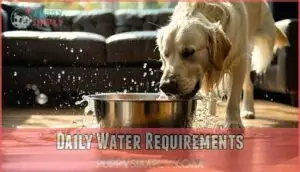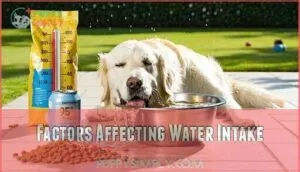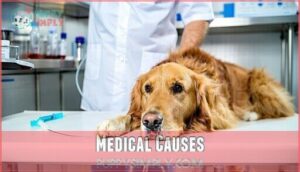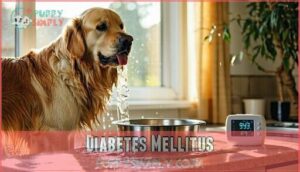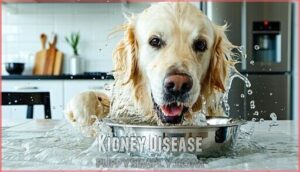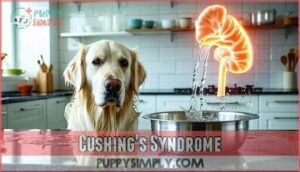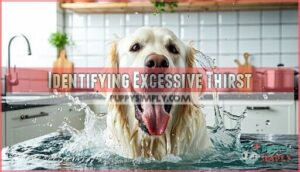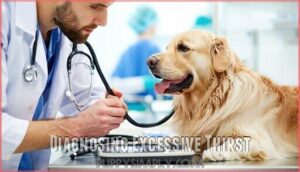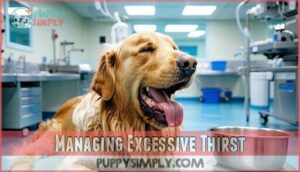This site is supported by our readers. We may earn a commission, at no cost to you, if you purchase through links.
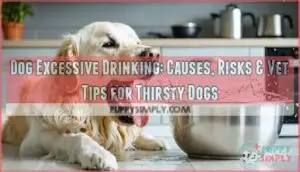
Dog excessive drinking can be a sign of an underlying health issue, such as diabetes or kidney disease.
If you’re concerned, monitoring your dog’s water intake and watching for other symptoms like increased urination or vomiting is vital.
Consulting with a vet is key to determine the cause and develop a plan to address it, and understanding the reasons behind your dog’s thirst is key to providing the best care.
There’s more to explore on this topic, including how to provide the best care and what other symptoms to watch for, such as increased urination.
Table Of Contents
- Key Takeaways
- Dog Water Intake Guidelines
- Causes of Excessive Drinking
- Identifying Excessive Thirst
- Diagnosing Excessive Thirst
- Managing Excessive Thirst
- Frequently Asked Questions (FAQs)
- Why is my dog drinking so much water?
- What does it mean if your pet drinks too much water?
- Why is my dog drinking so much?
- Can a dog drink a lot of water?
- Should I be concerned if my dog is drinking more water than usual?
- What is considered excessive drinking for dogs?
- Why has my dog suddenly started drinking more?
- Can dogs drink too much water at night?
- How often should I weigh my dog?
- Are certain breeds prone to overhydration?
- Conclusion
Key Takeaways
- You’ll want to monitor your dog’s water intake, as excessive drinking can be a sign of an underlying health issue, such as diabetes or kidney disease, and it’s crucial to consult a vet to determine the cause.
- Your dog’s water intake can fluctuate based on several factors, including climate, activity level, diet, and age, so it’s essential to understand these variables to recognize normal drinking patterns versus concerning changes.
- If you notice your dog drinking more water than usual, you should watch for other symptoms like increased urination, vomiting, or changes in appetite, as these can indicate a potential health problem that requires veterinary attention.
- You can manage your dog’s excessive thirst by working with your vet to develop a plan that may include fluid therapy, medication, dietary changes, or surgery, depending on the underlying cause, and it’s vital to track your dog’s progress and adjust their care accordingly.
Dog Water Intake Guidelines
You want to know how much water your dog should drink to stay healthy, and these guidelines help you track their daily needs and spot when something’s off.
Understanding a dog’s typical water intake, and the factors that affect it, can make a big difference in their long-term well-being.
Monitoring your dog’s water intake is key to their long-term health and happiness.
Daily Water Requirements
You manage your dog’s water intake by considering ideal hydration needs, typically 1 ounce per pound of body weight daily, influenced by activity levels, dietary factors, age, and climate.
Dehydration can be a serious issue, potentially leading to kidney disease, to promote proper canine hydration and dog water consumption for peak health.
Factors Affecting Water Intake
Your dog’s water intake fluctuates based on several factors beyond basic body weight requirements.
Understanding these variables helps you recognize normal drinking patterns versus concerning changes that warrant veterinary attention.
Key factors influencing dog water intake:
- Climate influence and activity levels – Hot weather and increased exercise boost water needs through panting and evaporative cooling
- Diet types – Dry kibble requires more water consumption compared to moisture-rich canned food
- Medication effects – Diuretics, corticosteroids, and anti-seizure drugs can increase thirst substantially
- Breed tendencies – Water-loving breeds like Labradors naturally drink more, while age affects consumption patterns
Canned Food Diet
Feeding canned food naturally reduces your dog’s water intake since wet food contains substantially more moisture than dry kibble.
This higher water content means dogs on canned food diets typically drink less from their bowls, which can help with weight management and dental health.
However, monitor for changes in drinking patterns, as polydipsia in dogs can still occur regardless of diet type.
Many owners choose this popular option for their pets, considering the benefits of canned food.
Dry Food Diets
You’ll find that dry food diets require more water due to lower kibble water content, affecting hydration strategies and potentially leading to dog excessive drinking or polydipsia in dogs.
Unlike canned food diet, so supplementing moisture is key to preventing dog drinking a lot.
Large breeds especially benefit from food with glucosamine and chondroitin to support joint health and overall well-being, making it a crucial consideration for their dietary needs, with polydipsia being a potential issue if not addressed properly.
Causes of Excessive Drinking
When your dog starts drinking more water than usual, it’s important to know that both medical and behavioral causes could be behind this change.
Conditions like diabetes, kidney disease, Cushing’s syndrome, or even stress and boredom may all play a role in excessive thirst.
Medical Causes
Beyond simple dehydration, serious medical conditions trigger polydipsia in dogs.
Electrolyte imbalances, kidney disease, and Cushing’s disease are common culprits. Diabetes insipidus, liver infections, and hypercalcemia also increase thirst.
Pyometra in unspayed females creates life-threatening fluid imbalances. These underlying health issues require immediate veterinary attention for proper diagnosis and treatment.
A dog’s daily water consumption exceeding 100 mL per kg of body weight is considered excessive.
Diabetes Mellitus
When you spot dog diabetes symptoms like a sudden dog thirst increase, it’s time to think about diabetes mellitus.
This condition causes increased thirst in dogs, along with weight loss and more frequent urination.
Insulin therapy is the main treatment, paired with dietary management and close blood glucose monitoring. Stay alert for complications, and follow your vet’s monitoring tips for best results.
Kidney Disease
A dog drinking a lot might be showing early signs of kidney disease. As kidneys fail, polydipsia and increased urination are common.
Watch for:
- Proteinuria management and phosphorus control are key in treatment.
- Hydration strategies help prevent dehydration.
- Dialysis options exist for advanced kidney disease stages.
- Regular monitoring is essential for dog kidney failure.
Always consult your vet if you notice dog thirst increase. A vet may recommend low phosphorus diets to help manage the condition.
Cushing’s Syndrome
Cushing’s disease in dogs—caused by cortisol overproduction from the adrenal glands, often due to pituitary tumors—leads to dog thirst increase (polydipsia).
Cushings disease dog symptoms include excessive drinking and urination. Diagnosis challenges can delay care, but treatment options like medication or surgery exist.
Early recognition of dog health conditions like Cushings disease helps manage risks.
| Symptom | Cause | Treatment Options |
|---|---|---|
| Polydipsia | Cortisol Overproduction | Medication, Surgery |
| Increased Urine | Adrenal Glands | Regular Monitoring |
| Hair Loss | Pituitary Tumors | Dietary Management |
The provided table outlines the symptoms, causes, and treatment options for Cushing’s disease in dogs, emphasizing the importance of understanding the adrenal glands role in the disease.
Behavioral Causes
Sometimes, a dog’s excessive drinking isn’t about health—it’s about behavior. You might notice:
- Boredom drinking or attention-seeking behavior, especially in playful breeds.
- Habitual drinking from stress-related thirst or big changes at home.
- Psychogenic polydipsia, a behavioral condition where dogs drink without a medical cause.
Breed tendencies and dog behavioral drinking patterns often play a role in these situations, involving complete concepts that are crucial to understanding the issue.
Identifying Excessive Thirst
You’ll want to watch for signs like frequent trips to the water bowl, increased urination, or changes in your dog’s daily drinking habits.
Noticing these patterns early can help you and your vet address potential health concerns before they become serious, which is why it’s crucial to be aware of your dog’s daily drinking habits.
Symptoms and Signs
When you notice a water bowl emptying faster than usual, pay attention.
Sudden thirst, polydipsia, and increased urination are classic symptoms of excessive thirst in dogs.
Watch for weight changes, appetite changes, and lethargy signs, too.
These clues often go hand-in-hand with increased thirst in dogs.
Dog dehydration symptoms can also appear, so don’t ignore these warning signs.
Immediate attention to dog dehydration treatment can be life-saving.
Drinking Water and Throwing Up
After spotting symptoms like polydipsia, you might see your dog drinking a lot, then vomiting.
This could be simple regurgitation vs vomiting, but persistent episodes hint at underlying causes needing a diagnostic approach.
Watch for:
- Watery vomit after rapid drinking
- Signs of dehydration
- Vomiting with diarrhea
- Lethargy or appetite loss
- Need for vet intervention and home care
Drinking Water and Licking Paws
When your dog starts gulping down water and licking their paws nonstop, it’s not just quirky behavior—it could be a sign of canine polydipsia or even allergies.
Paw licking causes range from dehydration signs to obsessive licking linked with stress.
Check the table below for quick insights:
| Symptom | Possible Cause |
|---|---|
| Excessive thirst | Polydipsia |
| Paw licking | Allergy connection |
| Obsessive licking | Behavioral correlation |
| Dry gums | Dehydration signs |
| Dog drinking a lot | Medical issue |
The symptoms can indicate various issues, including dehydration signs, and it’s crucial to identify the underlying cause, whether it’s a medical issue or a behavioral correlation, to provide appropriate care for your dog.
Drinking Water and Increased Urination
If you notice your dog drinking a lot and peeing more often, you might be dealing with canine polydipsia and increased urination.
These changes can signal issues with kidney function, bladder control, or electrolyte balance. Watch for dehydration risks and monitor urination frequency.
Here’s what to keep an eye on:
- Frequent accidents indoors
- Large puddles
- Restless pacing
- Sudden thirst
This situation requires careful observation to identify potential health issues, including problems with kidney function.
Diagnosing Excessive Thirst
When your dog starts drinking more than usual, it’s important to figure out what’s causing the change.
Your veterinarian will use exams, bloodwork, and imaging tests to identify any underlying health issues and guide treatment.
Veterinary Examinations
During a veterinary diagnosis, your vet starts with a thorough Physical Exam and History Review, asking about your dog’s habits and recent changes.
They’ll check essentials monitoring—like heart rate and hydration.
Using diagnostic tools, your vet may spot clues pointing to the cause of excessive thirst, and expect advice on follow-up care and further diagnostic tests if needed, which will help with follow-up care.
Bloodwork and Urinalysis
After your vet’s exam, bloodwork and urinalysis are next.
Sample collection is quick, and these tests reveal dog dehydration symptoms, kidney disease dog issues, and dog urinary problems.
Blood tests and urinalysis check baseline values, result accuracy, and help guide treatment.
Test interpretation and monitoring frequency matter, so don’t skip these steps—they’re key to understanding what’s really going on, with accurate results.
X-rays and Ultrasound
Once bloodwork and urinalysis point to deeper issues, your vet may suggest imaging techniques like X-rays or ultrasound.
These tools allow for organ visualization, helping spot kidney disease in dogs or detect dog urinary problems.
Anomaly detection is key, and imaging also guides procedures or checks healing after treatment.
The average X-ray cost typically ranges from $150-$250.
Veterinary diagnostics like these bring peace of mind and clearer answers, providing a sense of security for pet owners.
Managing Excessive Thirst
When your dog drinks more water than usual, you’ll need a clear plan to address the cause and protect their health.
Managing excessive thirst often involves treatments like fluid therapy, medication, dietary changes, or surgery, depending on your veterinarian’s diagnosis.
Fluid Therapy
Sometimes, fluid therapy is the lifeline for dogs facing dehydration or electrolyte imbalance.
You’ll see different therapy types, like intravenous fluid therapy, depending on the dog fluid imbalance.
Routes of administration vary—IV, subcutaneous, or oral.
Monitoring hydration and electrolyte balance is key to prevent complications.
Always work closely with your vet to guarantee safe, effective treatment and steady recovery.
Medication
After fluid therapy, your dog may need medications to manage excessive thirst.
Diuretics and anti-seizure meds often increase thirst, while corticosteroid impact can also trigger dog fluid imbalance.
Watch for medication interactions that cause dog electrolyte imbalance or worsen drug side effects.
If you notice changes, talk with your vet about dog medication side effects and possible adjustments.
Dietary Changes
Diet plays a big role in your dog’s hydration.
High food sodium levels or salty treats can make your pup drink more, so watch those labels.
Homemade dog food and raw food risks mean you’ll need to make certain proper hydration from food.
Consider limiting sodium content in your dog’s diet.
Supplementing water intake and making dog nutrition adjustments can help maintain a balanced diet and support healthy dog hydration.
Surgery and Other Treatments
When managing excessive thirst, you may consider surgical options or alternative therapies.
Post-op care and monitoring medication side-effects are essential.
Veterinary treatment, including fluid therapy, can help with long-term management, ensuring your dog receives the best care and treatment options for a healthy recovery.
Some pet owners are now exploring veterinary holistic treatments to complement conventional methods, focusing on veterinary holistic treatments for a more comprehensive approach, which can lead to a healthy recovery.
Frequently Asked Questions (FAQs)
Why is my dog drinking so much water?
Let’s face it, your furry friend’s thirst might be a red flag, so you’re wisely wondering why they’re drinking so much water, possibly due to health issues or environmental factors.
What does it mean if your pet drinks too much water?
If your pet drinks too much water, it may indicate an underlying medical issue, such as diabetes or kidney disease, so you should consult a veterinarian to determine the cause.
Why is my dog drinking so much?
Notably, your dog’s excessive water intake might signal an underlying issue, so monitor their behavior and consult a vet to rule out potential health problems, ensuring their well-being.
Can a dog drink a lot of water?
You can monitor your dog’s water intake, as they typically drink 1/2 to 1 ounce per pound of body weight daily, with variations based on activity, diet, and climate conditions.
Should I be concerned if my dog is drinking more water than usual?
If your dog’s water intake suddenly increases, it may signal an underlying issue, so consult a vet to rule out potential health problems.
What is considered excessive drinking for dogs?
You should consider drinking excessive if your dog consumes over 100ml of water per kilogram of body weight daily, exceeding normal intake guidelines.
Why has my dog suddenly started drinking more?
You’re wondering why your dog suddenly drinks more, possibly due to medical issues, changes in diet, or environmental factors.
So this is vital to track their habits and consult a vet.
Can dogs drink too much water at night?
You should check if your dog’s nighttime water intake exceeds normal limits, as excessive drinking can indicate underlying health issues, so track their habits to identify potential causes.
How often should I weigh my dog?
As you navigate your pet’s health, weigh them monthly, or weekly for pups, to track growth and detect potential issues early, making adjustments to their care for ideal well-being.
Are certain breeds prone to overhydration?
Some breeds, like Labrador Retrievers and Golden Retrievers, seem to love water and may drink more than others.
While true overhydration is rare, keep an eye on your dog’s habits, especially if they’re water-loving types.
Conclusion
As you navigate your dog’s excessive drinking, remember it’s a puzzle to solve.
You’re taking the first step by acknowledging the issue, now consult a vet to address the underlying cause of your dog’s excessive drinking.
Work together to find a solution for your dog’s excessive drinking habits.
- https://scholar.google.com/scholar_lookup?title=National+Research+Council.+Nutrient+Requirements+of+Dogs+and+Cats&publication_year=2006a&
- https://www.ncbi.nlm.nih.gov/pmc/articles/PMC6305449/
- https://pangovet.com/?utm_source=dogster&utm_medium=article&utm_campaign=dog_eat_drink
- https://www.webmd.com/pets/dogs/my-dog-always-thirsty
- https://www.bellaandduke.com/dogs/expert-advice/dog-health/how-much-water-should-dogs-drink/

